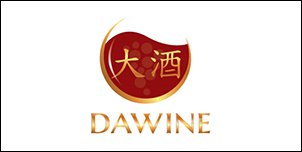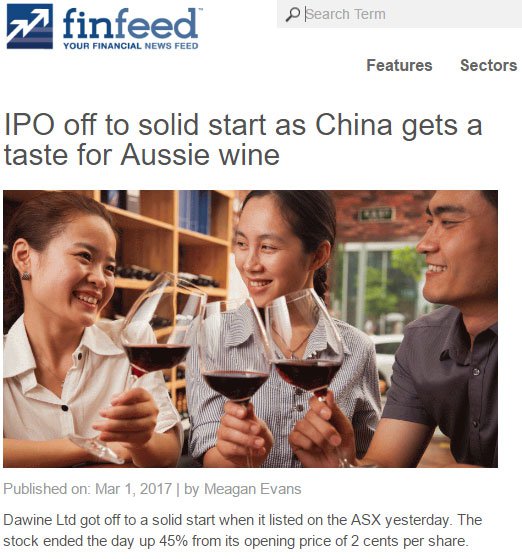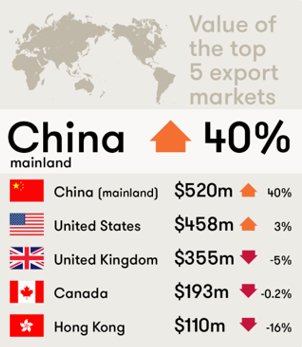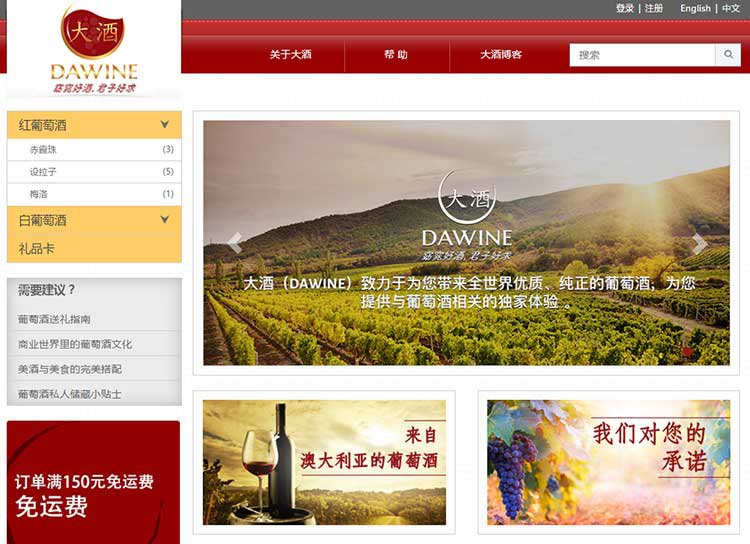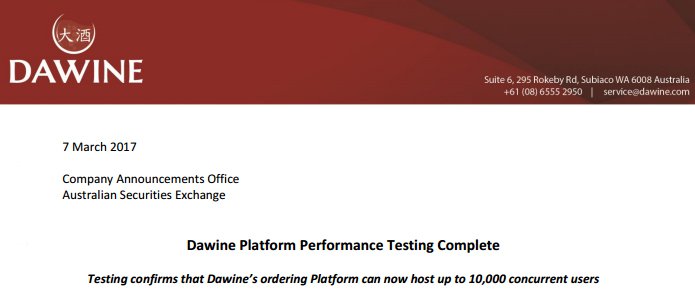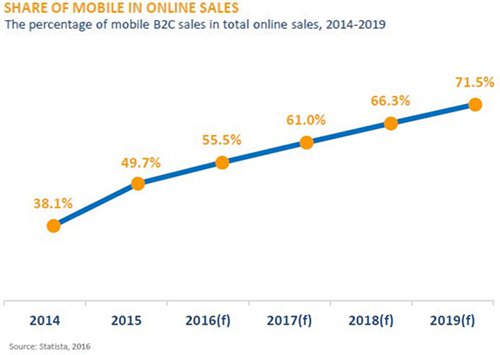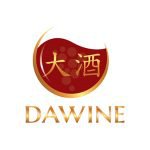Cheers! ASX Stock Uncorking China’s Fast Growing Wine Market
Published 09-MAR-2017 10:29 A.M.
|
13 minute read
Hey! Looks like you have stumbled on the section of our website where we have archived articles from our old business model.
In 2019 the original founding team returned to run Next Investors, we changed our business model to only write about stocks we carefully research and are invested in for the long term.
The below articles were written under our previous business model. We have kept these articles online here for your reference.
Our new mission is to build a high performing ASX micro cap investment portfolio and share our research, analysis and investment strategy with our readers.
Click Here to View Latest Articles
We all know Australians love a drink.
It used to be beer that was the staple of the great Australian barbeque, but that has slowly been usurped by wine – which is now drunk by 45.1% of the population compared with 37.6% who still love to blow the froth off the top of an amber ale.
The Chinese now seem to be cottoning onto wine as a drink of choice too.
Ten years ago, wine sales to China were worth just $27 million, now they are worth more than half a billion dollars...
In 2011 China had 19 million wine drinkers. By 2020 the number is expected to be 70-80 million.
Clearly, Chinese consumers are rapidly changing their drinking habits with a newfound fondness for wine — Australian wine in particular.
Interestingly the current consumption figures account for just 4% of all alcohol consumed, but this is changing before our eyes with the Chinese taking a keen interest in the alcoholic beverages that can be produced from the humble grape.
The $8.9 billion-capped Treasury Wine Estates (ASX: TWE) has leveraged off the rising Chinese demand for Aussie wines – and today’s tiny $11.7 million capped company is hoping to do the same thing.
Although of course, as this is still an early stage company, so investors considering this stock for their portfolio should seek professional financial advice before making an investment decision.
In what is now the biggest e-commerce market in the world, expected to hit $1.1 trillion by 2020,
This ASX stock has created a custom e-commerce online wine market for Chinese consumers.
Through its platform, this company offers quality wine from around the world and has been fully implemented in both Chinese and English language formats, as the company attempts to uncork what could be a very lucrative Chinese market.
The platform allows this company to track all inventory and orders in real time and updates customers with the progress of their order.
So this company is not only twisting the bottle cap on a burgeoning wine market, it is also tapping into an ever expanding Chinese e-commerce market.
Despite China being the biggest e-commerce market in the world, by 2019, only 51.7% of the Chinese population will be engaging in e-commerce activities, meaning there is even greater upside, particularly as more established markets such as the US, Japan and the UK will have over 70% participation.
You’d expect China to catch up quite rapidly, which would be a boon for this company and its wine sales.
This recently listed company, which has $3 million in the bank from an oversubscribed capital raising, is keen to crack this attractive Asian market with huge growth potential.
It already has a warehouse in Shanghai that is fully stocked with wine sold through its online platform and ready to distribute. It also has relationships with winemakers that have enabled it to sell exclusive wines in limited quantities to the Chinese market.
This company is perfectly positioned to capitalise on a major shift occurring in Chinese drinking habits and it has all the systems in place to leverage the opportunity.
With the company currently worth around $11.7 million on the market there’s plenty of room to spring like the vine.
Introducing...
Dawine Ltd. (ASX: DW8) is a newly listed Australian wine distribution company targeting the rapidly expanding Asian wine market.
The Australian based wine distributor recently undertook a reverse takeover of Brand New Vintage (ASX: BNV) and officially changed its listed name to Dawine in early March, with the new ASX code of DW8.
DW8 offers consumers in China the opportunity to purchase authentic wine from around the world via their personal computers, tablets and mobile phones.
The company has secured a business license, food circulation permit, wholesale liquor license and import license and has completed registration of a wholly foreign owned entity in China. It has also thoroughly tested its platform and with its Chinese warehouse stocked with wine is raring to go.
To get to this point, and to get the listing off the ground, DW8 raised $3 million in a heavily oversubscribed capital raising that will hold it in good stead as it attempts to get liquid in what is fast becoming a highly lucrative market.
Prior to this DW8 spent three years focused on developing a suitable Chinese platform and portal to take to the market. That included fully functioning logistics, warehousing and supply channels to sell and deliver wine both into the growing Chinese market and throughout the country.
Why?
Well just look at these statistics...
For wine consumption:
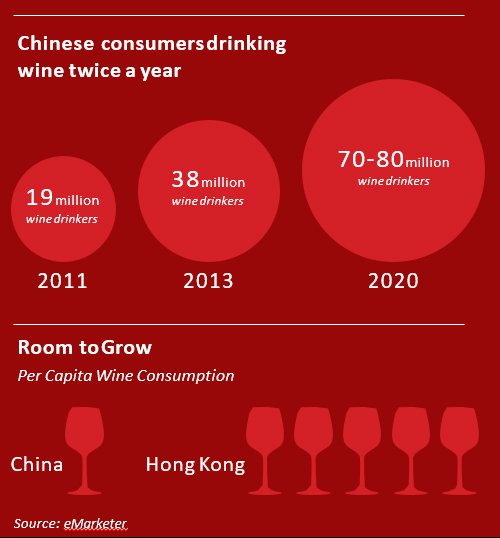
And for Chinese e-commerce:
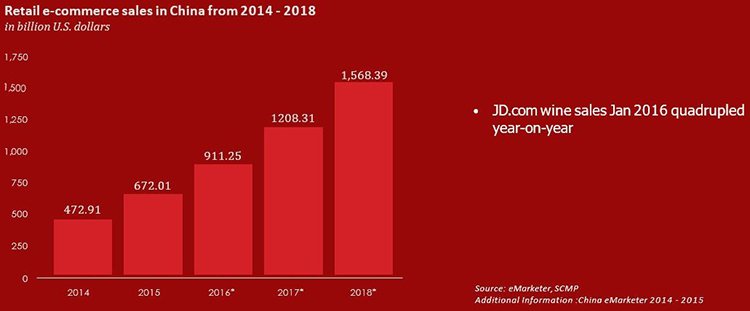
The start of a golden period in Australian wine exports to China?
Wine sales in China were estimated to be around $520 million for 2016, making China the single biggest market for Australian wine.
Australian wine makers are also gaining market share over wine bought in China from other regions.
This, along with the fact that close to half of all existing Chinese wine drinkers plan to drink more wine in the future than they do now, is one reason Morgan Stanley thinks we’re entering a golden period.
And that’s while wine still makes up just 4% of all alcohol consumed in China.
In the past Chinese consumers have had more of a taste for beer and the Chinese alcoholic beverage, baijiu, than wine. But as trends change and the Chinese develop more Western tastes they are taking a shine to wine.
Chinese consumers also view wine as being a healthier alternative to beer and baiju, plus they see Australian wine as being a premium product.
DW8 has formed unique relationships with winemakers, so that the wines sold by the company are often available in only limited quantities and exclusive to the Chinese market.
It already has numerous wine producers from Australia and France signed up, with more knocking on its door.
When choosing wines, DW8 focus on its core principles that a good bottle of wine must be of ‘quality, authenticity and affordability’.
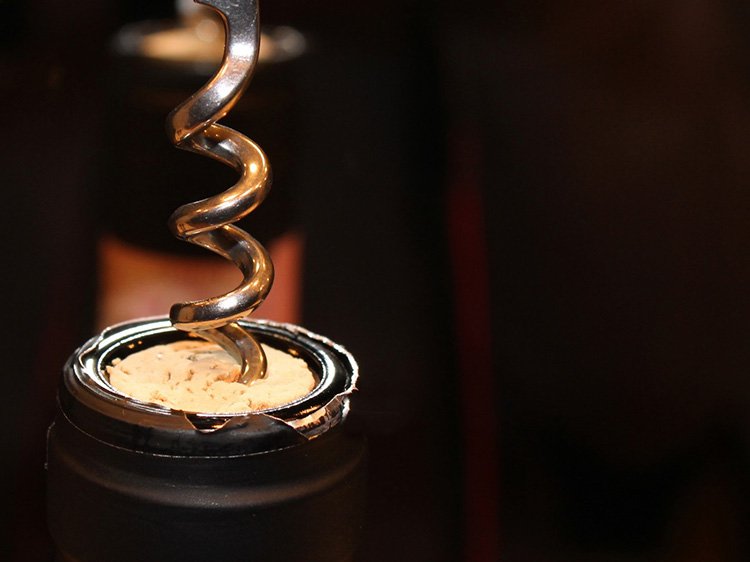
There’s huge growth potential for a wine distributor that has the product, plus the systems in place to get it in front of buyers and delivered.
And that’s all taken place despite restrictive tariffs on exports to China which have only been cut in the past year.
That’s the icing on the cake for Australian wine exporters, who are already benefitting from the major cultural shift taking place with Chinese drinkers getting a taste for wine... and Australian wine in particular.
As you can see the market dynamics are all working in favour of Australian wine exporters to China.
But above and beyond the favourable macro view, DW8 has intelligently positioned itself for its best chance of success —utilising its management’s significant knowledge and expertise to leverage off the tail wind of the wider market.
DW8 is led by wine enthusiast and finance professional, Piers Lewis — an experienced company secretary, Director of resource companies Ardiden Ltd and former Director of Talga Resources, which he helped float and develop.
Lewis, along with the rest of the management team, share significant experience in efficiently running businesses, understanding producer needs, and building online platforms.
DW8’s recently launched, custom-built platform is targeting the Asian retail wine market with a focus on agility, scalability and extendibility.
The platform was custom built by DW8 to handle the company’s unique business model, ensure maximum flexibility, adapt to China’s unique requirements and to be able to quickly pivot on any newly identified opportunities and partnering agreements.
For customers, it makes buying wine online easy —purchases can be made across desktop computers, tablets and mobile device, with the convenience of the website, mobile website, plus Android and iOS apps.
Assembled from the ground up by the DW8 team in China, the platform has been fully implemented in both Chinese and English allowing for error free communication between Australian based management, Chinese staff and local Chinese consumers.
It effortlessly deals with China’s internet particularities and offers the same real time experience to users within and outside China. And thanks to its adaptability it can be easily retooled for launch other countries.
From an administrative perspective, the platform allows DW8 to track all inventory and orders in real time. Customers are updated with the progress of their order via the platform so that they know where their order is at all stages of the process, down to the final delivery to their home.
DW8 will provide multiple sales models that are targeted to suit the Chinese market. A subscription service is also on the cards.
Being able to distribute nationwide has been an issue in the past for wine distributors in Asia with established distributors having limited reach, with just provincial capabilities.
DW8 has tackled head on this stumbling block to wine distribution throughout Asia, by addressing the technological and logistical issues that others encountered.
It has a complete Enterprise Resource Planning (ERP) system in place to ensure a smooth operation from imports and inventories to purchase and distribution.
In a major step for DW8’s growth, performance testing has now been completed on the company’s platform. The finalised platform will increase its customer base and expand business opportunities.
On March 7, DW8 reported that the team had load tested the custom ERP and eCommerce Platform (www.dawine.com) to more than 10,000 concurrent users or 3.5 million interactions per hour.
DW8 also has a functioning warehouse in Pudong, Shanghai that is already stocked with wine sold through its online platform and ready to distribute... with more on the way.
The climate controlled warehouse, in the city’s free trade zone, is accompanied by established offices and staff. Additionally, DW8 has offices set up in Hong Kong.
As the world’s largest retail e-commerce market, China is fully embracing the online shopping revolution.
Online wine sales in particular, are poised for huge growth as online shopping becomes more and more commonplace.
Currently, the value of e-commerce in China is said to be around US$672 billion, and by 2019 that market is expected to almost triple in value to US$1,973 billion.
The following chart shows the forecast growth of online sales in China:
Plus, half of all Chinese wine drinkers already buy online, so the combination of rising e-commerce sales plus the trend towards wine as the drink of choice points to solid growth for online wine sales and retailers such as DW8.
Additionally the introduction of the China-Australia Free Trade Agreement can supercharge wine exports to China.
It’s been just over a year since the China-Australia Free Trade Agreement (ChAFTA) was signed, and already wine exports to China have grown by over 50% — bumping China above the US and the UK as Australia’s number one wine export destination.
And still, the ChAFTA is not yet in full effect.
The tariffs are being cut gradually, with reductions made each year. In the case of wine, before the agreement exporters were paying a 14% on all exports to China. This was cut to the 8.4% last year, which then fell again to 5.6% beginning in 2017. And further cuts are still to come.
When it’s all said and done 95% of all exports to China will be free of tariffs.
In China, wine is flying off the shelves and more so out of the warehouses, as overall e-commerce sales keep growing in the world’s largest e-commerce market. That’s in parallel with consumers growing taste for wine.
This places DW8 in an enviable position. DW8 has recognised the opportunity that comes with this paradigm shift and has positioned itself in the early stages to take full advantage of this growth and change.
It should be noted, however, that this is an early stage tech company and success is no guarantee. Investors should seek professional financial advice before making an investment.
Australian wine exporters have paved the way...
yet new players are needed to keep pace with rising demand.
Treasury Wine Estates (ASX: TWE) is one well known company that has leveraged off the rising Chinese demand for Aussie wines.
The $8.8 billion-capped wine company saw the growth potential in the Chinese market for Australian wines and adjusted its business model to tap the lucrative market.
And the pay day came quickly with TWE’s Asian profits soaring 16-fold in just three years. Booming sales to China bumped its half-year profits in the six months to December 31 2016, to $79 million — up from just $5 million at that time in 2013.
Higher profits margins helped this result. TWE’s Asia margins rose to 36.2% last quarter, up from 28.6% a year earlier.
Shareholders of Treasury Wines [ASX:TWE] have done well too, more than tripling its market share price in three years from less than $4 per share to more than $12:
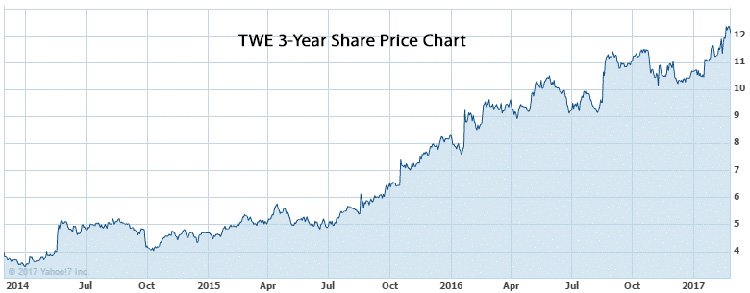
The past performance of this product is not and should not be taken as an indication of future performance. Caution should be exercised in assessing past performance. This product, like all other financial products, is subject to market forces and unpredictable events that may adversely affect future performance.
But being the ASX’s major wine stock and gaining so much interest that comes with that title, TWE is now looking a bit expensive.
Consider that its PE ratio — which is a measure of a company’s share price compared to the earnings it generates — is at 35 times. That’s well above the ASX average, which typically sits around 15 times earnings.
That means that the upside for TWE investors may be limited.
A less well known company, which has some similarities to DW8 is Australian beer exporter to China, Broo Ltd (ASX: BEE). Since listing on the ASX in October last year , the $200 million-capped company has gotten off to a strong start.
Broo is leveraged to many of the same drivers as DW8, mainly consumers growing tastes for western style foods and beverages, along with increased discretionary spending.
Yet the Chinese beer market is much more competitive than the wine space. Five global giants control 80% of all sales in China, including American majors SABMiller and Anheuser-Busch.
By contrast the wine market is less established – and therein lies the opportunity for a company like DW8.
Fortunately for DW8’s early shareholders, wine is yet to gain mainstream consumer recognition – offering potential for forward thinking investors to potentially capitalise on the growing Chinese market for Australian wine that the company is leveraged to.
Of course, there are no guarantees of DW8’s success and it remains speculative at this stage. Those considering this stock should seek independent financial advice.
The company now appears to have all its ducks in a row, plus the larger macro environment suggests that a company like DW8 is well positioned to take a slice of the lucrative Chinese wine market.
Firstly, overall wine consumption by Chinese consumers is rising rapidly with both the proportion of wine drinkers rising, plus the amount consumed by existing drinkers climbing too.
Then there’s the growing e-commerce market with the popularity of buying wine online already established.
DW8 is poised to launch a digital marketing campaign in which success will further shore up confidence for DW8 and its China wine tilt.
Cheers!
General Information Only
This material has been prepared by StocksDigital. StocksDigital is an authorised representative (CAR 000433913) of 62 Consulting Pty Limited (ABN 88 664 809 303) (AFSL 548573).
This material is general advice only and is not an offer for the purchase or sale of any financial product or service. The material is not intended to provide you with personal financial or tax advice and does not take into account your personal objectives, financial situation or needs. Although we believe that the material is correct, no warranty of accuracy, reliability or completeness is given, except for liability under statute which cannot be excluded. Please note that past performance may not be indicative of future performance and that no guarantee of performance, the return of capital or a particular rate of return is given by 62C, StocksDigital, any of their related body corporates or any other person. To the maximum extent possible, 62C, StocksDigital, their related body corporates or any other person do not accept any liability for any statement in this material.
Conflicts of Interest Notice
S3 and its associated entities may hold investments in companies featured in its articles, including through being paid in the securities of the companies we provide commentary on. We disclose the securities held in relation to a particular company that we provide commentary on. Refer to our Disclosure Policy for information on our self-imposed trading blackouts, hold conditions and de-risking (sell conditions) which seek to mitigate against any potential conflicts of interest.
Publication Notice and Disclaimer
The information contained in this article is current as at the publication date. At the time of publishing, the information contained in this article is based on sources which are available in the public domain that we consider to be reliable, and our own analysis of those sources. The views of the author may not reflect the views of the AFSL holder. Any decision by you to purchase securities in the companies featured in this article should be done so after you have sought your own independent professional advice regarding this information and made your own inquiries as to the validity of any information in this article.
Any forward-looking statements contained in this article are not guarantees or predictions of future performance, and involve known and unknown risks, uncertainties and other factors, many of which are beyond our control, and which may cause actual results or performance of companies featured to differ materially from those expressed in the statements contained in this article. S3 cannot and does not give any assurance that the results or performance expressed or implied by any forward-looking statements contained in this article will actually occur and readers are cautioned not to put undue reliance on forward-looking statements.
This article may include references to our past investing performance. Past performance is not a reliable indicator of our future investing performance.

